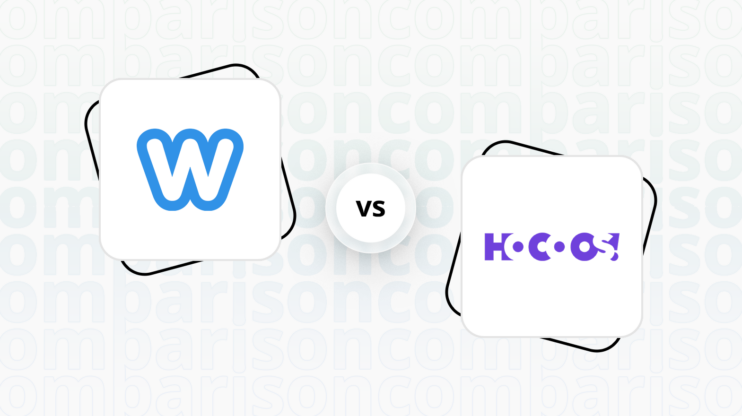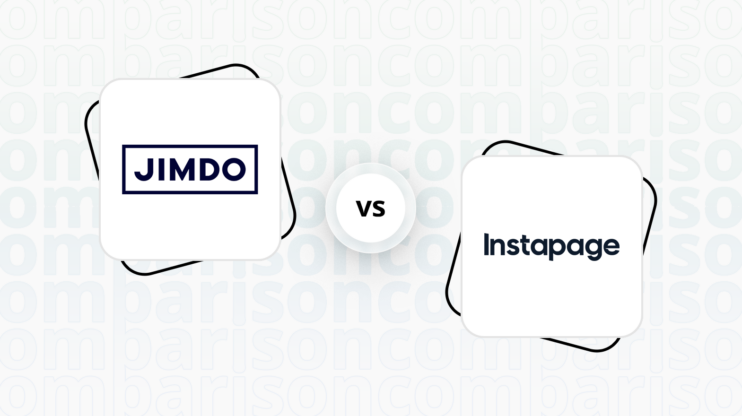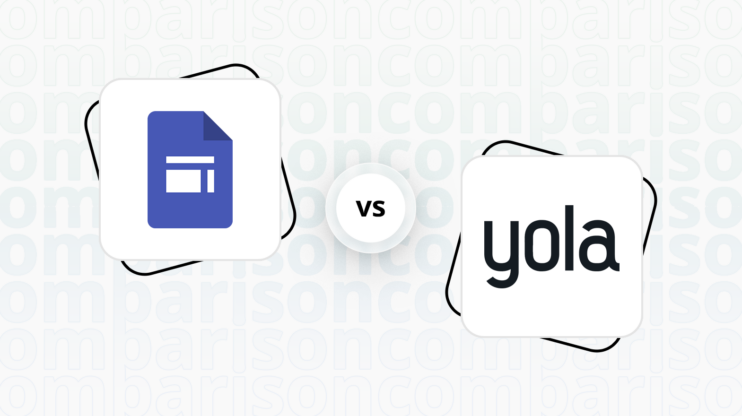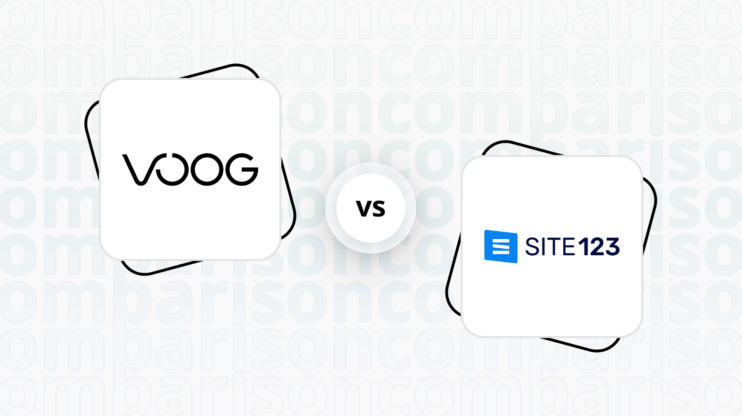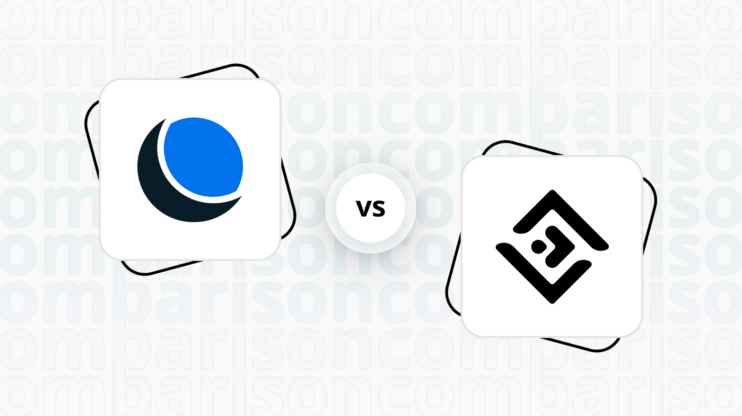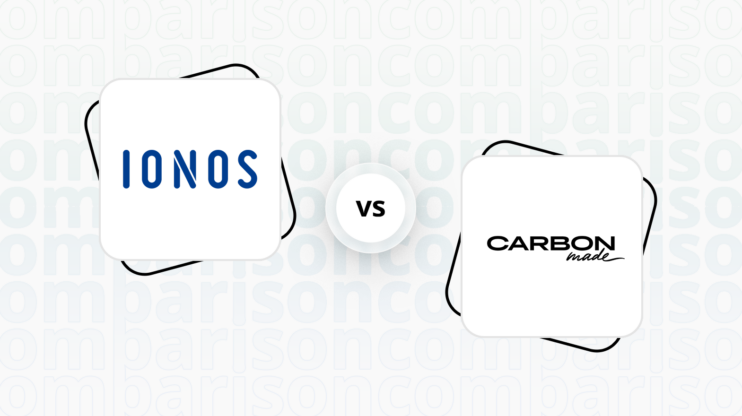Final verdict
BlueHost and Webflow both offer robust platforms, but they cater to different user needs and preferences.
-
BlueHost (Overall Grade: 6.8/10)
is a versatile web hosting service with an integrated website builder, making it a solid choice for users who want to create professional-looking websites easily. Its seamless integration with WordPress, user-friendly drag-and-drop interface, and a variety of hosting plans cater to a broad audience, from personal blogs to large online businesses. However, when comparing BlueHost vs Webflow, BlueHost may fall short in advanced design functionalities and ecommerce capabilities. -
Webflow (Overall Grade: 7.9/10)
excels in providing a comprehensive solution for professional designers and developers. It offers powerful design tools, a flexible CMS, and top-tier hosting services, making it ideal for creating custom, responsive websites without extensive coding knowledge. In the BlueHost vs Webflow comparison, Webflow stands out with its superior design functionalities, ecommerce features, and overall user experience, making it a preferred choice for those seeking high customization and advanced web development capabilities.

|

|
|
|---|---|---|
|
Design functionalities & templates |
7.2 |
8.6 |
|
Ease of use |
8.2 |
7.5 |
|
Ecommerce |
6.8 |
8.5 |
|
Website Editors |
7.3 |
9.0 |
|
Product testing options |
6.2 |
6.3 |
|
Price |
7.2 |
8.0 |
|
Hosting quality |
8.0 |
8.9 |
|
Website speed optimization |
6.5 |
8.1 |
|
Plugins and integrations |
9.1 |
5.5 |
|
Marketing features |
7.3 |
7.8 |
|
Customer support |
7.6 |
8.3 |
|
Security |
8.3 |
7.8 |
|
AI capabilities |
1.5 |
8.3 |
|
User Management |
4.4 |
8.3 |
| Overall |
6.8 |
7.9 |
Best for ecommerce
 6.8
6.8
 8.5
8.5
Verdict
: BlueHost is suitable for users seeking a straightforward ecommerce solution integrated with WordPress, while Webflow excels with its advanced customization and robust ecommerce features.
-
BlueHost
: BlueHost offers a user-friendly website builder with seamless WordPress integration, making it a good choice for those who prefer using WooCommerce for their ecommerce needs. It provides essential ecommerce features like product listings, shopping carts, and secure payment gateways. However, in the BlueHost vs Webflow comparison, BlueHost’s ecommerce capabilities are more basic and may not meet the needs of larger or more complex online stores. -
Webflow
: Webflow stands out with its powerful design tools and extensive customization options, making it ideal for professional designers and businesses looking for a highly customizable ecommerce platform. It supports a wide range of payment gateways, advanced product page customization, and robust marketing features. In the BlueHost vs Webflow comparison, Webflow’s higher score reflects its superior ecommerce capabilities and flexibility.
Best for informational & business websites
 7.5
7.5
 8.6
8.6
Verdict
: When it comes to creating informational and business websites, Webflow takes the lead with its powerful design tools and flexible CMS, making it ideal for professional designers. BlueHost, while versatile and user-friendly, is better suited for users who prefer a simpler, WordPress-integrated solution.
-
BlueHost
: BlueHost offers a user-friendly website builder that integrates seamlessly with WordPress, providing access to thousands of themes and plugins. Its drag-and-drop interface makes it accessible for users with little to no coding experience. With a score of 7.5, BlueHost is a solid choice for those looking to create professional-looking websites easily, especially if they prefer the WordPress ecosystem. -
Webflow
: Webflow stands out with its robust design experience and powerful CMS, scoring 8.6. It allows users to build and launch responsive, cleanly-coded websites without extensive coding knowledge. Webflow’s comprehensive solution, which includes top-tier hosting services, makes it a preferred choice for professional designers and businesses looking for high customization and advanced design features. In the BlueHost vs Webflow comparison, Webflow’s superior design tools and flexibility make it the better option for creating custom, responsive websites.
Detailed comparison
Design functionalities & templates
Design FunctionalitiesRepresents how well each platform allows for creative design and customization of websites.Score Components:
- Template Variety (30%): Range and quality of design templates.
- Customization (30%): Flexibility and options for design alterations.
- User Interface (20%): Ease and intuitiveness of the design process.
- Responsiveness (10%): Adaptability to different devices and screen sizes.
- Innovation (10%): Unique design features and tools.
 7.2
7.2
 8.6
8.6
🏆
Winner: Webflow.
If you’re looking for a platform that offers more creative control and a wide array of design features, Webflow is the preferred choice.
BlueHost’s WordPress website builder offers over 300 pre-installed templates and designs to cater to the diverse needs of its users, ensuring that there’s something for everyone, regardless of the niche or industry. With hundreds of customizable templates available, users can easily find a design that aligns with their vision and brand identity.
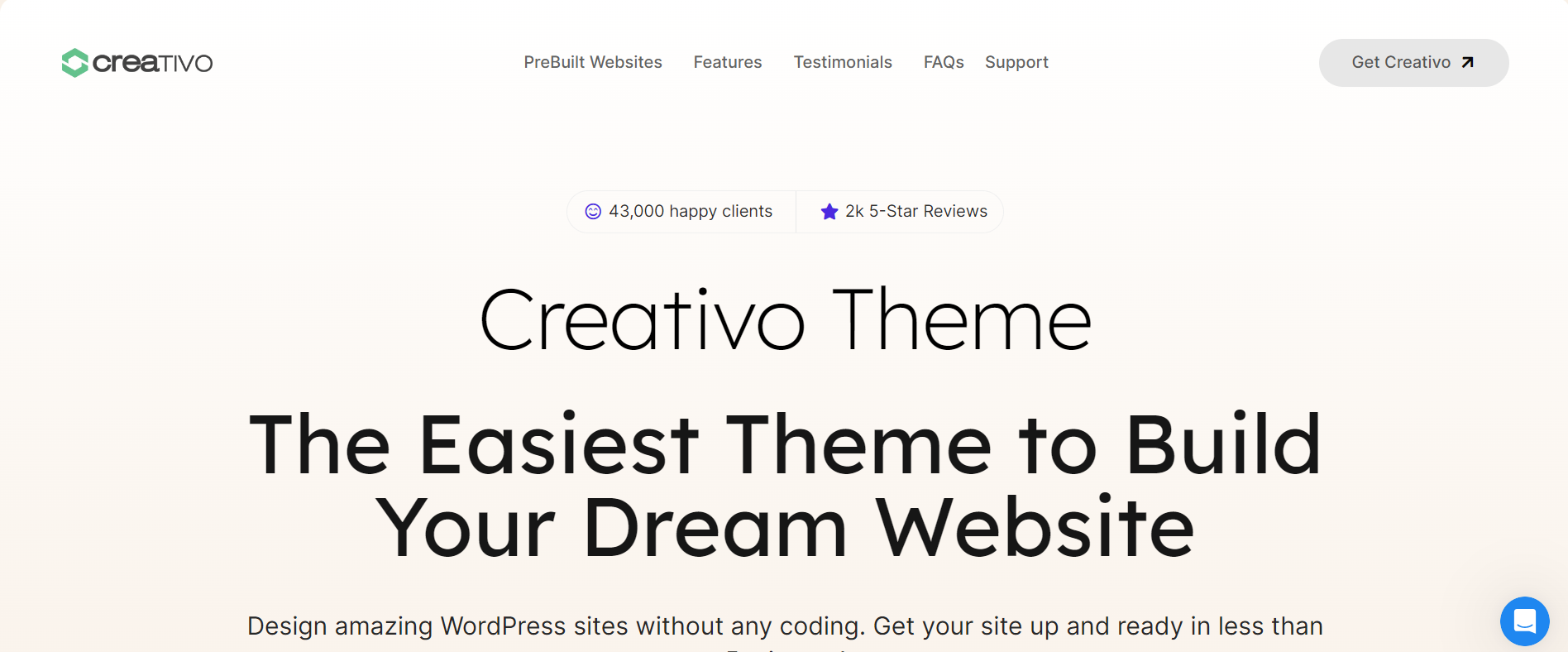
Compared to BlueHost, Webflow delivers a robust design experience with a diverse range of template and customization options. Boasting over 1000 pre-built templates covering various industries and website types, including free and premium options, Webflow ensures a constantly evolving library for users.
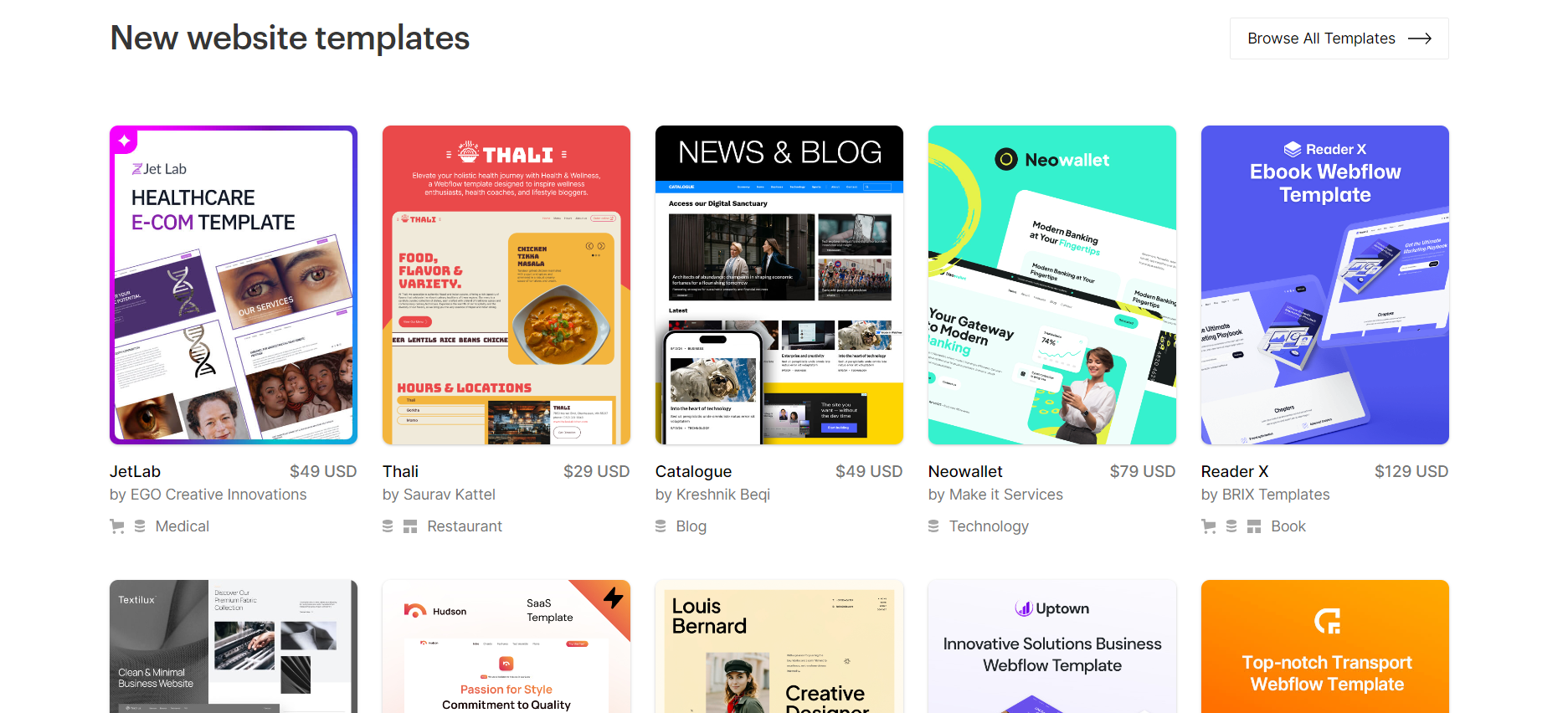
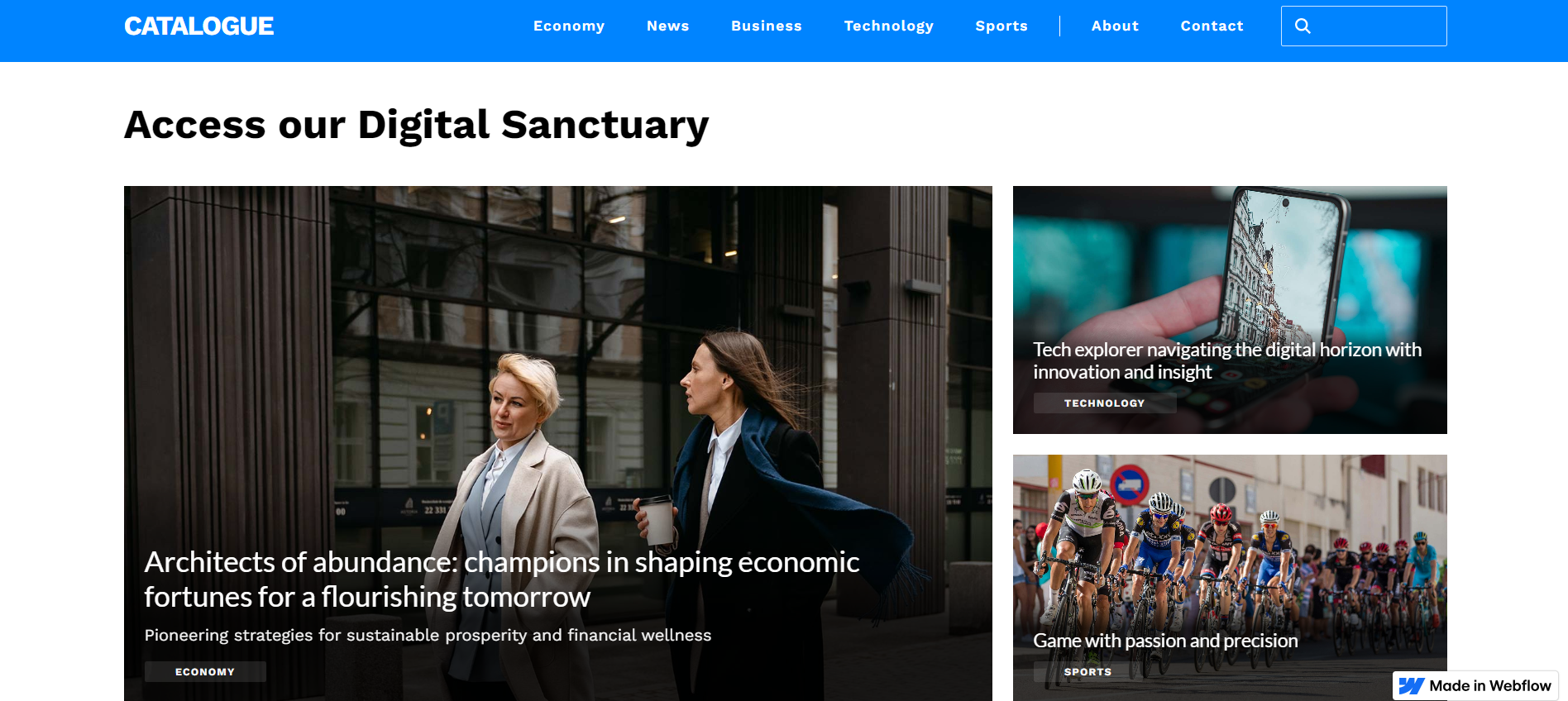
Get a head start on website creation with AI
Create a custom website tailored to your business needs 10X faster with 10Web AI Website Builder!
Ease of use
Ease of useReflects the platform’s overall user-friendliness.Score
Components:
- Learning curve (40%): Quickness and ease of getting started.
- Interface design (30%): Simplicity and intuitiveness of layout.
- User guidance (20%): Quality of tutorials and support.
- Flexibility (10%): Adaptability to various user skills.
 8.2
8.2
 7.5
7.5
🏆 Winner: BlueHost
. With a score of 8.2, BlueHost’s user-friendly interface and drag-and-drop features make it a more accessible option for users of all skill levels. Webflow, scoring 7.5, offers a visually intuitive interface but has a steeper learning curve, making it more suitable for experienced designers and developers.
Learning Resources
🏆 Winner: Webflow
. Both platforms offer comprehensive learning resources, but Webflow’s diverse courses, tutorials, and active community forums provide a more extensive learning experience for users.
For ecommerce
EcommerceMeasures the platform’s effectiveness in supporting online business activities.Score Components:
- Ecommerce themes and templates (20%): Variety and design of templates.
- Product management (25%): Ease of managing and organizing products.
- Payment options (25%): Variety and convenience of payment methods.
- Ecommerce features (20%): Features for managing an ecommerce store.
- Integration (10%): Compatibility with external e-commerce tools and services.
 6.8
6.8
 8.5
8.5
When it comes to ecommerce, Webflow outperforms BlueHost with a score of 8.5 compared to BlueHost’s 6.8. Webflow’s robust platform allows for easy store creation without coding, extensive customization options, product management with variations, inventory tracking, and integration with major payment gateways. On the other hand, BlueHost’s ecommerce features are designed to help users build and manage online stores effectively, with integration with WooCommerce for WordPress sites, allowing for the easy setup of product listings, shopping carts, and secure payment gateways.

|

|
|
|---|---|---|
|
Ecommerce themes and templates |
6.5 |
7.5 |
|
Product page customization |
7.0 |
8.3 |
|
Payment processing and commissions |
6.8 |
7.8 |
|
POS capabilities |
0.0 |
6.5 |
|
Payment gateways |
7.5 |
8.0 |
|
Product numbers |
6.0 |
7.0 |
|
Additional ecommerce features |
6.5 |
7.9 |
BlueHost ecommerce features:
- Product Listings
- Shopping Carts
- Secure Payment gateways
- Shipping Options and Tax Calculations
- Inventory Management
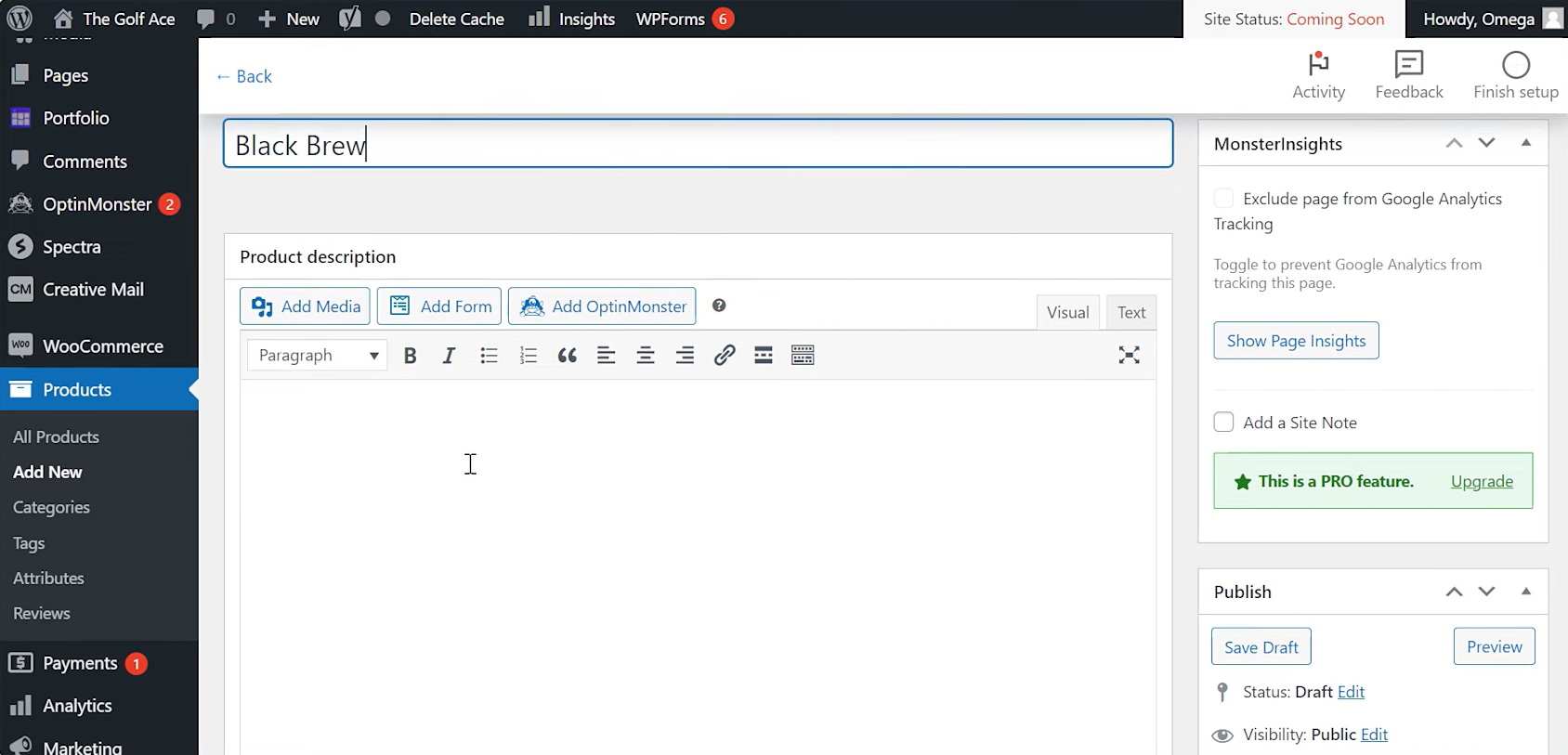
Webflow ecommerce features:
- Checkout and Payment Processing with Stripe, PayPal, etc.
- Marketing and Promotions
- Tax and Shipping calculations
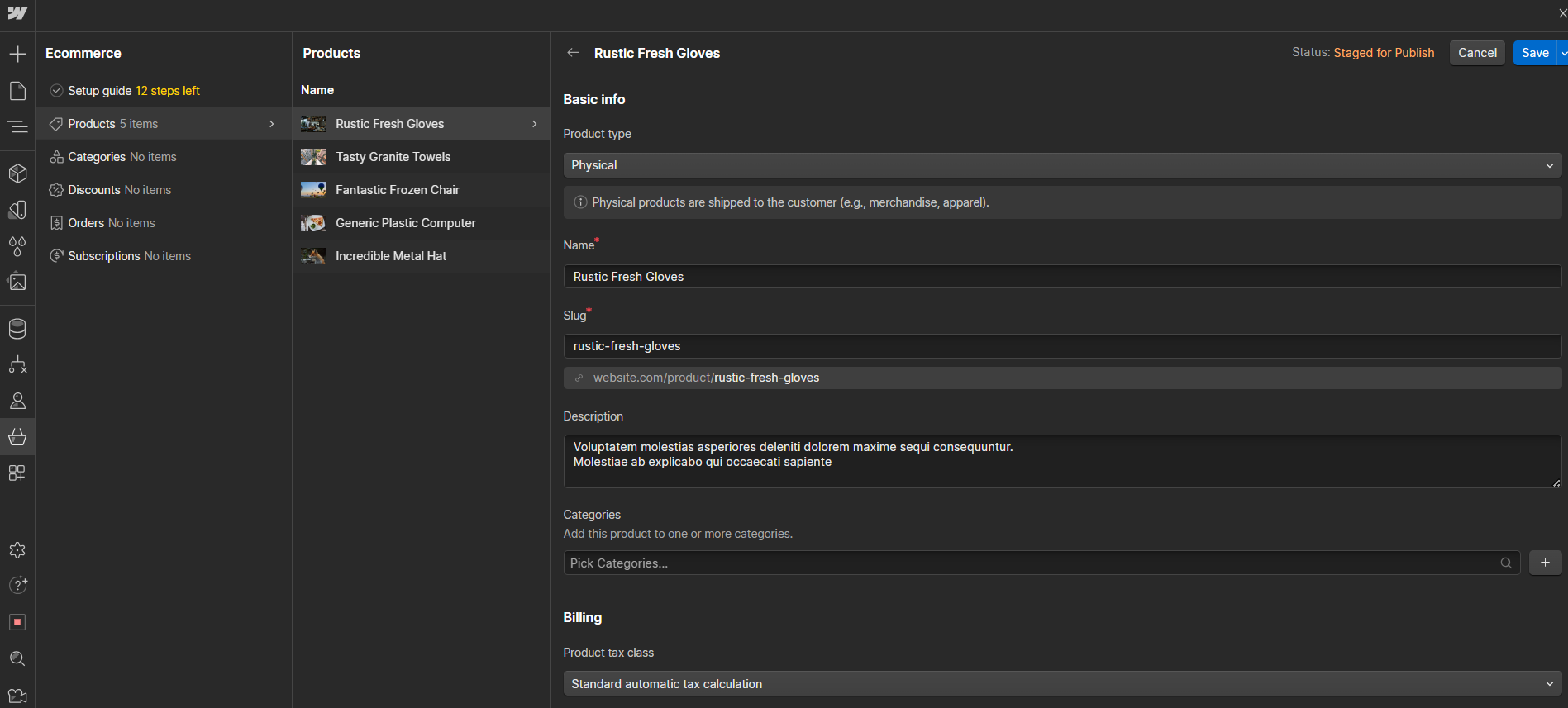
Ecommerce themes & templates
BlueHost’s website builder for eCommerce provides a selection of specific templates designed to streamline the creation of online stores. These templates are optimized for sales, featuring designs that accommodate product galleries, shopping carts, and checkout processes. However, the customization options might be limited compared to more specialized eCommerce platforms. In contrast, Webflow offers a diverse range of ecommerce themes and templates designed to cater to various types of online stores. Each template comes equipped with built-in ecommerce functionality, allowing you to easily add products and manage your store without the need for coding.
Product page customization
BlueHost’s website builder offers robust customization features for product pages, allowing users to tailor product details like titles, descriptions, images, and pricing according to their preferences. It supports the creation of product variants and options, facilitating the sale of items with multiple choices such as size, color, and material directly from the product page. On the other hand, Webflow offers extensive customization options for eCommerce product pages, allowing users to design and personalize their pages without coding. It provides tutorials for creating product pages from scratch, offers responsive templates for various devices, and allows users to add custom code and dynamic content using Webflow’s CMS for maximum customization flexibility.
Payment processing
BlueHost doesn’t directly support numerous payment gateways. However, it does integrate with WooCommerce, a platform that facilitates integration with various payment gateways like PayPal and Stripe. While BlueHost doesn’t impose transaction fees, the payment gateways might. Furthermore, it lacks Point of Sale (POS) capabilities. In contrast, Webflow provides a flexible and secure platform for payment processing and ecommerce through integrations with leading payment gateways like Stripe and PayPal. This allows users to accept a wide range of payments, including credit card transactions directly from their websites. Given the versatility of Stripe and PayPal, businesses can manage online sales efficiently, and these integrations likely support various transaction types, potentially including POS transactions for physical sales environments.
Website Editors
Website EditorsEvaluates the platforms’ website building and editing capabilities.Score Components:
- Customization tools (40%): Range and power of editing features.
- Editor usability (30%): User experience within the editor.
- Design flexibility (20%): Freedom in layout and design changes.
- Update and maintenance ease (10%): Simplicity of updating and maintaining the site.
 7.3
7.3
 9.0
9.0
🏆
Winner: Webflow
. Webflow, with a score of 9.0, is a cloud-based platform that combines web design, CMS, and hosting, enabling users to visually design responsive websites without writing code. It offers a drag-and-drop interface, integrated SEO tools, ecommerce functionalities, and the ability to add animations and interactions, making web development accessible for designers and powerful for developers. Webflow streamlines the process of web creation, from design to launch, offering both high customization and ease of use.
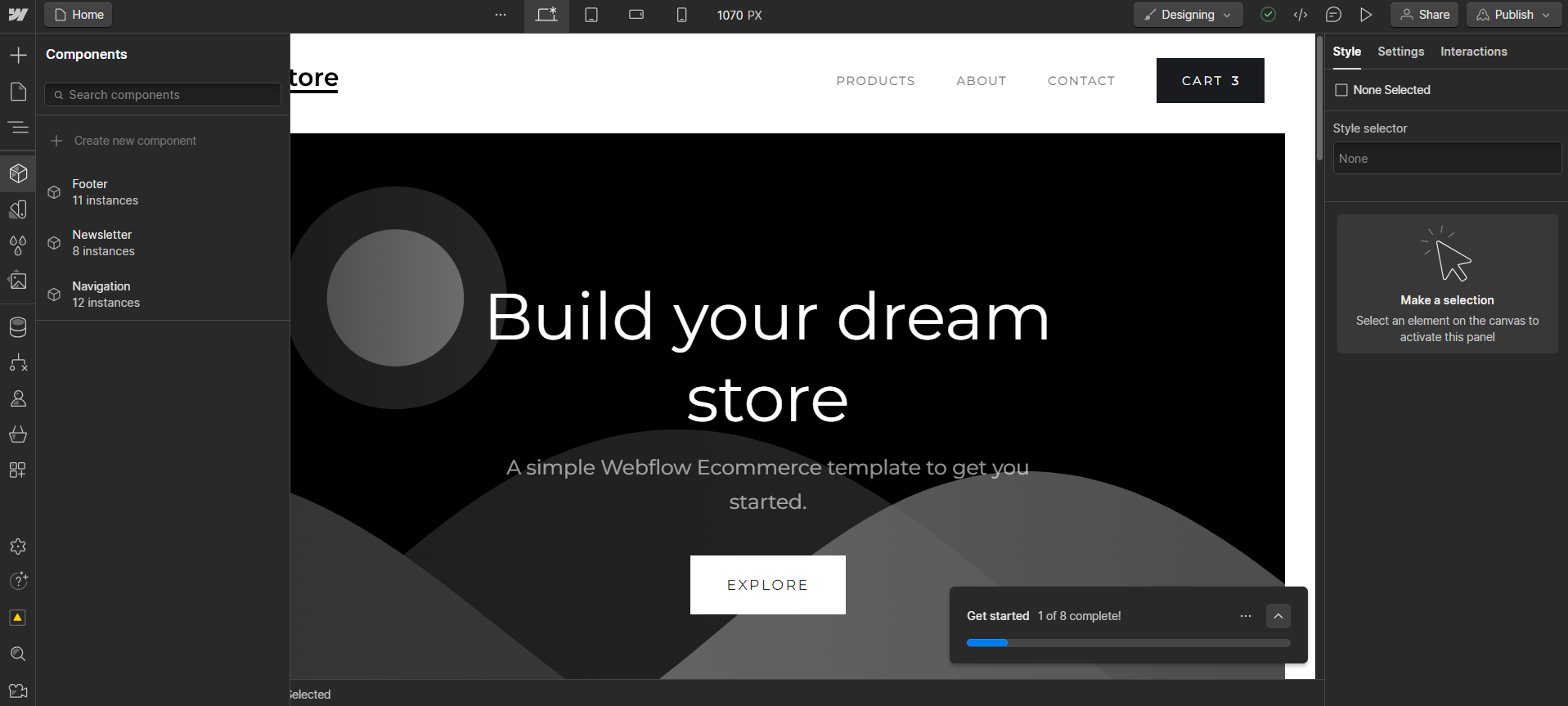
BlueHost’s website builder editor, scoring 7.3, is designed for ease of use, catering to both beginners and advanced users. It offers a section based drag-and-drop interface, allowing users to easily add, remove, and customize elements on their website without needing to code. Users can choose from a wide range of templates and customize them to fit their brand, including adjusting layouts, colors, and fonts. Additionally, the editor provides access to stock photos, SEO tools, and responsive design features, ensuring websites look great on all devices and can rank well on search engines.
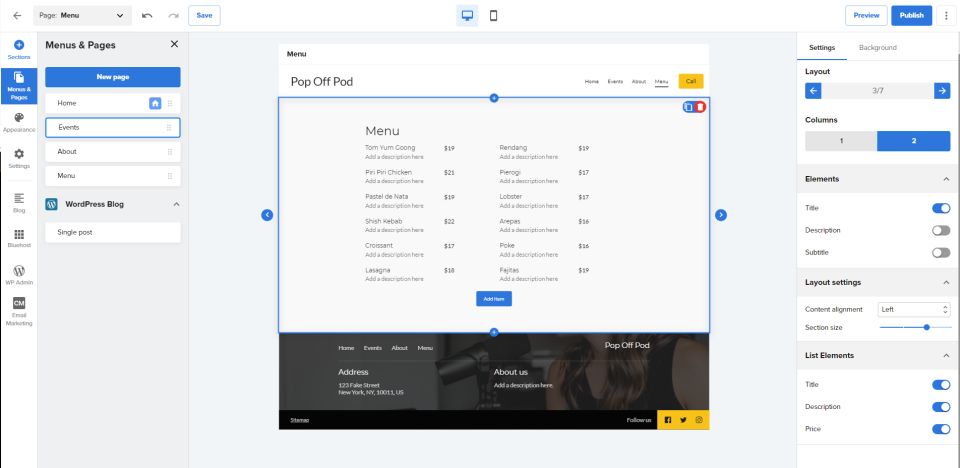
Mobile editor/app
 5.0
5.0
 7.0
7.0
🏆
Winner: Webflow
. Both BlueHost and Webflow do not have official mobile editor apps. However, Webflow has a third-party app called EditFlow, created by a community member for Webflow users. Currently, the app is only available for iOS. On the other hand, BlueHost allows editing on a mobile browser, but with some limitations. Considering these factors, Webflow has a slightly higher score than BlueHost.
Product testing options
Product Testing OptionsAssesses the options for trying out platform features before commitment.Score Components:
- Trial quality (40%): Extent and usefulness of the trial or free version.
- Feature accessibility (30%): How many features are available to test.
- Trial duration (20%): Length of the trial period.
- Ease of transition (10%): Smoothness of moving from trial to paid plans.
 6.2
6.2
 6.3
6.3
Overall Result
:
Webflow wins
. Webflow scores slightly higher than BlueHost in product testing options, with a score of 6.3 compared to BlueHost’s 6.2. While neither platform offers a trial version, Webflow provides a free plan that allows users to test some basic features. BlueHost, on the other hand, does not have a free plan but allows users to test premium features within a 30-day refundable period.

|

|
|
|---|---|---|
|
Free Plan |
No |
Yes |
|
Trial Duration |
No | No |
|
Testing Premium Features |
Within 30-day refundable period |
Basic features with free plan |
|
Money Back Guarantee |
30-day money back guarantee |
No |
Price
PriceLooks at the cost-effectiveness and value for money of each platform.Score Components:
- Plan value (40%): What each pricing tier offers.
- Transparency and clarity (30%): Clearness of pricing structures.
- Flexibility of plans (20%): Range of options to suit different budgets.
- Hidden costs (10%): Additional expenses not included in the plan.
 7.2
7.2
 8.0
8.0
Webflow has a higher price score than BlueHost, indicating that it may offer better value for money.
Both platforms offer discounts for annual subscriptions, with BlueHost offering up to 80% off depending on the plan, and Webflow offering discounts ranging from 9 to 31% depending on the plan. While BlueHost does not offer an enterprise plan, Webflow offers a customizable enterprise plan for large companies with advanced needs.
| Price range |

|

|
|---|---|---|
|
Free |
No offering at this amount. |
Starter (Free): Limited features for new sites, including 2 static pages and 50 form submissions lifetime. |
|
$10-$20 |
Basic ($15.99/month): Made for a simple website or blog, 1 website with 10GB SSD storage, Free CDN, Free Domain 1st year, Managed WordPress Hosting, Free SSL 1st year and Chat Support. Value for price: 6.5 |
Basic ($18/month): Suitable for simple sites with a custom domain, including basic SEO controls and 500 monthly form submissions. And 100 pages. Value for price: 6.5 |
|
$20-$30 |
Choice Plus ($27.99/month): Ideal for multiple sites needing storage, security, backups, 3 websites with 40GB SSD storage, Free CDN, Free Domain 1st year, Managed WordPress hosting, Free SSL, Free Domain privacy 1st year, Malware scanning, daily site backups are free for the 1st year with the purchase of a 12 or 36-month package. Otherwise, users are required to pay a one-time fee of $35.88 for backup services. Value for price: 7.5 |
CMS ($29/month): For content-driven sites with 2,000 CMS items, 1,000 monthly form submissions, and full API access. And 150 website pages. Value for price: 7.5 |
|
$30-$35 |
Online Store ($32.99/month): Great for all online selling, built-in eCommerce tools, 3 websites with 40GB SSD storage, Free CDN, Free Domain 1st year, Managed WordPress hosting, Free Domain privacy 1st year, Malware Scanning, Exclusive Theme Store, Store Analytics, Unlimited products, Secure Payment options, Bookings & appointments, Shipping labels, product search and filtering, daily site backups are free for the 1st year with the purchase of a 12 or 36-month package. Otherwise, users are required to pay a one-time fee of $35.88 for backup services. Value for price: 8.5 |
No offering at this amount. |
|
$35-$45 |
Pro ($39.95/month): Perfect for high traffic, advanced storage, security, 5 websites with 100GB SSD storage, Free CDN, Free Domain 1st year, Managed WordPress hosting, Free SSL, Free Domain privacy 1st year, Malware Scanning, daily site backups are free for the 1st year with the purchase of a 12 or 36-month package. Otherwise, users are required to pay a one-time fee of $35.88 for backup services. Value for price: 9.0 |
Standard ($42/month): For new businesses with up to 500 ecommerce items, includes basic ecommerce features, and 2% transaction fee Value for price: 8.5 |
|
$45-$50 |
No offering at this amount. |
Business ($49/month): High traffic capacity, advanced features like site search, and up to 10 content editors. Value for price: 8.0 |
|
$80-$90 |
No offering at this amount. |
Plus ($84/month): Higher volume businesses with 0% transaction fees, up to 5,000 ecommerce items, and advanced features. Value for price: 9.0 |
|
$200+ |
No offering at this amount. |
Advanced ($235/month): Scalable solution for large online stores with up to 15,000 ecommerce items and the highest caps and 0% transaction fees. Value for Price: 9.5 |
location. As a result in rare cases the prices displayed here can differ from the ones you see on their
websites.
Hosting quality
Hosting
qualityExamines the reliability and performance of the hosting solutions.Score Components:
- Uptime (40%): Consistency and reliability of website availability.
- Speed (30%): Loading times and performance.
- Bandwidth and storage (20%): Sufficiency of resources provided.
- Data centers (10%): Quality and distribution of hosting infrastructure.
 8.0
8.0
 8.9
8.9
🏆
Winner: Webflow
Webflow’s managed hosting, with a 99.99% uptime and a globally distributed network of data centers from Amazon Web Services (AWS) and Fastly, provides a robust and reliable hosting solution. BlueHost, with a 99.9% uptime and 6 data centers, offers a range of hosting options, including managed WordPress hosting, making it a versatile choice. However, Webflow’s superior uptime and scalability give it the edge in this category.

|

|
|
|---|---|---|
|
Do they offer hosting? |
Yes, offers a range of hosting options |
Yes, included in all of their plans |
|
Data Centers: |
6 data centers: Orem and Provo, Shanghai, Mumbai and Hong Kong, London |
Webflow doesn’t actually have its own data centers. Instead, it relies on a globally distributed network of data centers from Amazon Web Services (AWS) and Fastly. |
|
Type of hosting: |
Managed WordPress Hosting |
Managed Hosting |
|
Uptime: |
99.9% |
99.99% |
|
Uptime Guarantee: |
Yes, 99.9% |
Only Enterprise plan, 99.99% |
Website Speed Optimization
Website Speed OptimizationEvaluates optimization of website loading timesScore Components:
- PageSpeed Score (30%): Google’s score indicating performance optimization.
- Loading Time (30%): The average time until a website is fully interactive.
- Mobile Optimization (15%): Optimization effectiveness for mobile devices.
- Resource Optimization (15%): Optimizing images, scripts, and other heavy resources.
- CDN Usage (10%): Use of CDN to enhance speed across geolocations.
 6.5
6.5
 8.1
8.1
🏆 Winner: Webflow
Both BlueHost and Webflow prioritize website performance and page speed, but Webflow’s comprehensive speed optimization strategies and better load times and PageSpeed scores give it the edge.

|

|
|
|---|---|---|
|
Focus |
CDN, Server Optimization |
Custom Cache Settings, Custom Element Lazy Loading, Automatic Minification, Responsive templates, CDN |
|
Performance Tools |
Google Lighthouse, PageSpeed Insights |
Google PageSpeed Insights Integration |
|
Key Strategies |
CDN, Server Optimization |
Custom Cache Settings, Custom Element Lazy Loading, Automatic Minification, Responsive templates, CDN |
|
Load Times |
Varies widely, depending on the optimization, website complexity |
Below 2 seconds average |
|
Page Speed Scores Range |
Varies widely, depending on the optimization, website complexity |
77.2/100 |
|
Core Web Vitals Improvement |
Emphasis on LCP, FID, CLS improvements |
Improving components’ usability, and emphasis on LCP, FID and CLS |
Webflow’s comprehensive speed optimization strategies include custom cache settings, custom element lazy loading, automatic minification, responsive templates, and a content delivery network (CDN). These strategies have resulted in an average load time of below 2 seconds and a PageSpeed score of 77.2/100. Webflow also focuses on improving components’ usability and the Largest Contentful Paint (LCP), First Input Delay (FID), and Cumulative Layout Shift (CLS) metrics.
BlueHost, on the other hand, focuses on CDN and server optimization to improve website speed. However, both its load times and PageSpeed scores vary widely, depending on the optimization and website complexity. Like Webflow, BlueHost also emphasizes on improving the LCP, FID, and CLS metrics.
Get a head start on website creation with AI
Create a custom website tailored to your business needs 10X faster with 10Web AI Website Builder!
Plugins and integrations
Plugins and integrationsMeasures the range and effectiveness of additional plugins and integrations.Score Components:
- Variety of options (40%): Range of available add-ons.
- Integration smoothness (30%): Ease of integrating plugins into the site.
- Quality of plugins (20%): Functionality and reliability of the options.
- Custom integration capabilities (10%): Support for custom or third-party integrations.
 9.1
9.1
 5.5
5.5
🏆 Winner: BlueHost.
With a score of 9.1, BlueHost takes the lead in this category. Its seamless integration with WordPress opens up a vast ecosystem of plugins and extensions, significantly expanding the functionality of the BlueHost website builder. Webflow, scoring 5.5, offers a built-in library of website elements and functionalities, and while it does integrate with a number of third-party services, it doesn’t quite match the extensive range of options available with BlueHost.
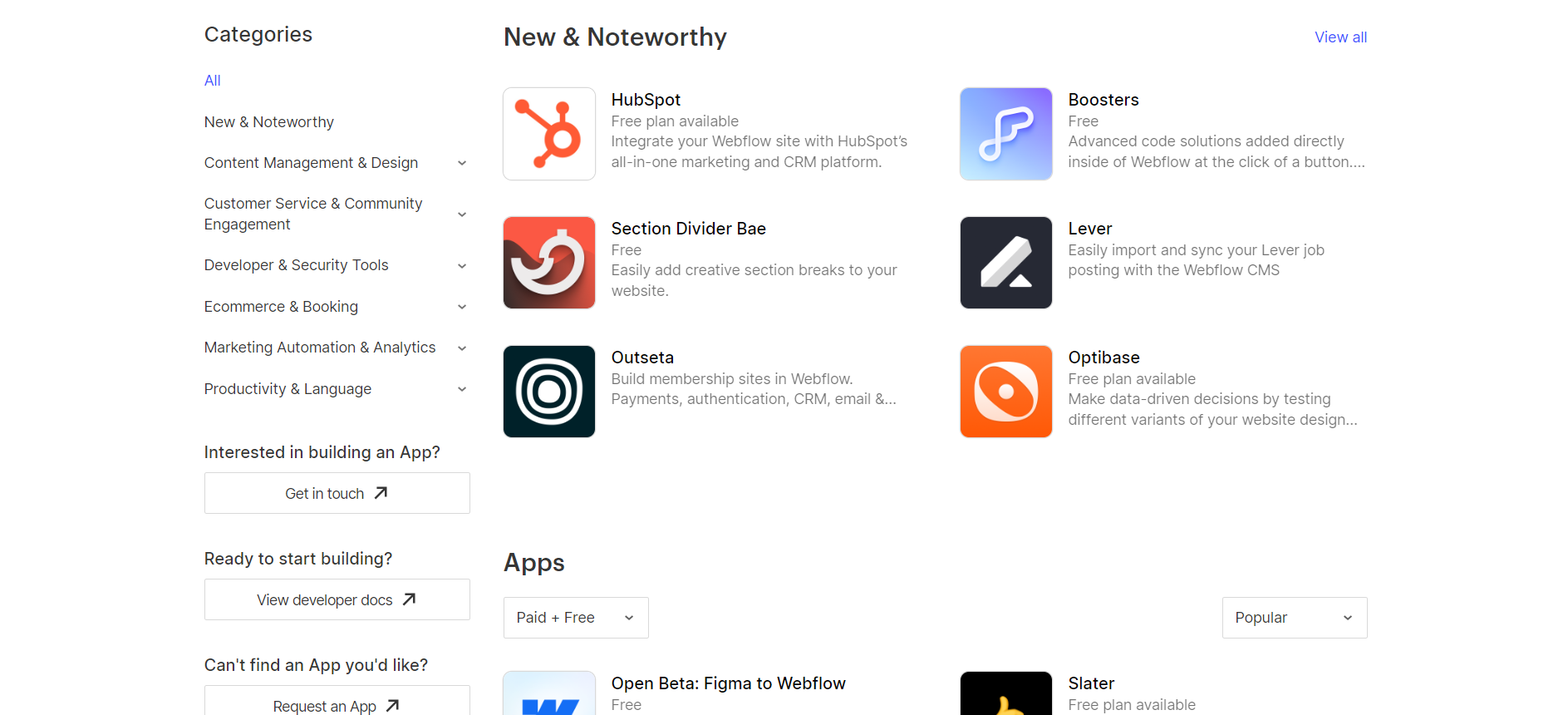
Marketing Features
Design FunctionalitiesRepresents how well each platform allows for creative design and customization of websites.Score Components:
- Template Variety (30%): Range and quality of design templates.
- Customization (30%): Flexibility and options for design alterations.
- User Interface (20%): Ease and intuitiveness of the design process.
- Responsiveness (10%): Adaptability to different devices and screen sizes.
- Innovation (10%): Unique design features and tools.
 7.3
7.3
 7.8
7.8
🏆
Overall Winner: Webflow
. Webflow edges out BlueHost with a slightly higher marketing features score, indicating more advanced or comprehensive features in this area. Both platforms offer a range of marketing tools, but Webflow’s integrations with popular marketing tools like Google Analytics and Mailchimp may give it an advantage.

|

|
|
|---|---|---|
|
SEO Tools |
|
|
|
Email Marketing |
|
|
|
Blogging |
|
|
|
Social Media Integration |
|
|
|
Analytics and Reporting |
|
|
|
Ads and Promotions |
|
|
Customer Support
Customer supportEvaluates the quality and availability of support options.Score Components:
- Response time (40%): Speed of support responses.
- Support quality (30%): Effectiveness and helpfulness of the support.
- Availability (20%): Range of support channels (phone, chat, email).
- Resource richness (10%): Quality of self-help and educational materials.
 7.6
7.6
 8.3
8.3
🏆 Winner: Webflow
. In the comparison of BlueHost vs Webflow, Webflow takes the lead with a customer support score of 8.3. Webflow offers 24/7 support through live chat, email, and a community forum, ensuring users have constant access to assistance. Additionally, Webflow provides extensive documentation and video tutorials, which are highly beneficial for troubleshooting and learning the platform.
BlueHost, with a customer support score of 7.6, also offers 24/7 support through chat and phone for general inquiries, and technical assistance is available from 7 a.m. to midnight EST. While BlueHost provides a variety of support options, it lacks the comprehensive documentation and community resources that Webflow offers, making Webflow the superior choice for customer support.
Security
SecurityLooks at the platforms’ security measures and data protection.Score Components:
- Data protection (40%): Safeguards for user and customer data.
- SSL and encryption (30%): Implementation of secure connections.
- Compliance (20%): Adherence to industry security standards.
- Regular updates (10%): Frequency of security updates and patches.
 8.3
8.3
 7.8
7.8
🏆
Winner: BlueHost
. BlueHost’s commitment to security is evident in its robust measures such as SSL certificates, regular backups, and additional security features like SiteLock for malware scanning. Compliance with data protection regulations and a commitment to privacy are central to their service, ensuring users’ data is handled securely.
Webflow, while not as highly scored as BlueHost, also takes security seriously. They implement robust encryption techniques and strict access controls, regularly update their systems, and conduct audits to identify and address any potential vulnerabilities. However, BlueHost’s comprehensive security measures give it the edge in this comparison.
AI Capabilities
AI capabilitiesMeasures the effectiveness of AI-driven features and tools.Score Components:
- Automation efficiency (40%): Impact of AI on streamlining processes.
- Personalization (30%): AI-driven customization for users or customers.
- AI-Assisted design (20%): Role of AI in website design and functionality.
- Data analysis (10%): Use of AI in interpreting user data and analytics.
 1.5
1.5
 8.3
8.3

|

|
|
|---|---|---|
|
AI Builder |
|
Announced, not yet available |
|
AI Ecommerce features |
|
|
|
AI content generation |
Available through WordPress plugins |
Announced, not yet available |
|
Additional AI features |
|
Announced, not yet available |
🏆 Winner: Webflow
. Although neither BlueHost nor Webflow currently offer AI capabilities, Webflow has announced plans to introduce AI features in the future. These include an AI co-pilot for design, AI-customized templates, and AI-powered content management capabilities. On the other hand, BlueHost does not have any AI capabilities, but it does support the integration of WordPress plugins, some of which may offer AI content generation features.
User Management
User ManagementAssesses the platforms’ capabilities in managing user roles, permissions, and accessibility.Score Components:
- Role Customization (40%): Flexibility in creating and defining user roles and
permissions. - Ease of Management (30%): User interface and tools for managing users.
- Access Control (20%): Effectiveness of access control measures for different user
levels. - Scalability (10%): Ability to manage a growing number of users efficiently.
 4.4
4.4
 8.3
8.3
🏆 Winner: Webflow
. Webflow offers a more comprehensive user management system compared to BlueHost.
- BlueHost does support multi-user management, however, there’s no mention about the number of users or their roles and permissions.
- In Webflow, the number of users who can edit a website and their access levels vary by plan. Core, Growth, and Enterprise plans offer unlimited editors, while others limit content editors to 3 or 10 per site. Access levels include Designer for full access and Editor for content editing. Workspace roles like Admin, Designer, and Editor ensure collaboration and security through features like the Site Activity Log and role-based permissions.
Webflow User Roles and Access Levels:
| Role | Description | Access Highlights |
|---|---|---|
| Workspace Owner | Full control over Workspace settings and member management. | Edit settings, manage billing, access/edit all sites, invite/remove members, manage permissions. |
| Workspace Admin | Similar to the owner with some restrictions. | Edit settings, manage billing, access/edit all sites, invite/remove members (except owner), manage permissions. |
| Workspace Member | Limited control focused on site interaction. | Download invoices, access/edit sites, invite members. |
| Workspace Guest | Temporary collaborators with limited access. | Access/edit sites. |
| Workspace Commenter | Limited to commenting for feedback on sites. | Create/view/resolve comments, preview sites. |
| Site Admin | Full control at the site level. | Manage permissions, delete/transfer sites, billing management, design and publish changes. |
| Can Design | Design capabilities with some restrictions on publishing. | Design in Designer, create/modify classes and components, publish changes with permission. |
| Can Design (Limited) | Restricted design capabilities for Enterprise customers. | Create new classes, modify created classes, limited publishing capabilities. |
| Can Edit | Content editing without full design privileges. | Edit text/links/images, manage assets, publish Collection items and Ecommerce products. |
| Can Comment (Site Level) | Commenting for feedback at the site level. | Create/view/resolve comments, preview sites. |
Additional Features

|

|
|
|---|---|---|
|
SSL Certificate |
|
|
|
Custom Domain |
|
|
|
Free Custom Domain Included |
|
|
|
International Domains |
|
|
|
Mobile Responsive |
|
|
|
Page Speed |
|
|
|
Website Builder Mobile App |
|
|
|
Convert a Website To An App |
|
|
|
Website Analytics |
|
|
|
Multilingual Sites |
|
|
|
Multiple Users |
|
|
User Feedback
Users appreciate BlueHost for its comprehensive free offerings, including SSL, subdomains, and custom email, along with additional services like free domain registration and CDN. The platform’s intuitive interface and user-friendly website builder cater to both beginners and experienced developers. However, concerns arise regarding the significant price increase upon renewal, limited free website templates, and unresolved technical issues with poor customer support, hindering users’ ability to effectively manage their websites and businesses. Addressing these concerns could enhance overall user satisfaction with BlueHost.
Webflow receives high praise for its user-friendly interface, eliminating the need for coding while offering extensive design flexibility. Users appreciate its scalability, cost-effectiveness, and seamless integration of essential features like forms and CMS. However, some users note a slight learning curve and occasional limitations, particularly in ecommerce functionalities and content management. Overall, Webflow proves to be a powerful tool for building and managing websites, offering robust features for both beginners and experienced developers, albeit with some room for improvement in certain areas like collaborative editing and content management.
The making of this blog
We followed a clear, step-by-step process to write and research this article.
FAQ
Which platform is better for ecommerce, BlueHost or Webflow?
Can I use BlueHost or Webflow for building an informational or business website?
How do BlueHost and Webflow compare in terms of ease of use?
Which platform offers better website speed optimization?
How do the platforms compare in terms of customer support?
Which platform is more secure?
Do BlueHost and Webflow offer AI capabilities?
Which platform is better for user management?
What additional features do BlueHost and Webflow offer?
What do users say about BlueHost and Webflow?










